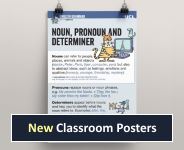Genre of Advertisements
Goals:
- Identify common discourse and register features of advertisements
- Analyse how these features are used to achieve the desired effects
- Plan, write and evaluate an advert using the same features
Lesson Plan
Before this lesson, you may want to complete the lesson An Introduction to Genre, so that learners are familiar with the key terms discourse structure and register
Please check if there are any hand outs at the bottom of this page and print in advance.
Warmer
Use the bulletpoints to introduce the topic and activate the pupils' prior learning. Circulate to monitor the discussion. You could use mini-whiteboards to share/check their answers for the third point.
Activity 1
Explain that learners must work in pairs or small groups. One half works with Advert A and the other with Advert B. Hand out the printed adverts. Learners then take turns to discuss the bulletpoints. Again, try using mini-whiteboards to share answers. Learners should start discussing language and structural features as these are the focus of the rest of the lesson.
Activity 2
Ask learners to recall the meaning of discourse structure and register features. They should be familiar with these terms from the introductory lesson.
Next, all learners looks at Advert A to identify and label the sections. As as an example, the headline is already labelled. After five minutes, compare with a partner.
Scaffolding: If learners are struggling, provide them with the names of the six sections: Title, Illustration, Body Copy, Logo, Brand Name, Slogan, and Contact Information.
Extension:
- Presentation features: quotation marks, bold text, underlining, bullet-points, short paragraphs
Finally, discuss what the purpose of these discourse features is. Why is the text designed in this way? Accept any answers related to helping the reader find information and to persuade/convince.
Activity 3
Have the learners read Advert A again and consider the question: What kind of tone does this text create? How does it attempt to persuade the audience? As shown in the next slide, learners should conclude that the text has a firendly and appraochable tone (of course, accept any equivalent descriptions).
Then, consider the next question: What features of language contribute to this tone? Use the bullet-points to help the learners' discussion. Use the mix and match activity to check what features the learners noticed. Add any extra features to the board.
Activity 4
Next, learners will look at a different aspect of language. Ask them to focus on the underlined words on the Advert A handout and answer the questions: What word classes do they belong to? What do these words have in common? Where are they placed in the text, and why? After a discussion, use the buttons to reveal some example answers.
To consolidate the previous activities, ask the learners to write two paragraphs, one analysing the discourse and presentation features, and the other analysing the register and language features. Select evidence and analyse how these features contribtue to the intended effect on the reader, bearing in mind the purpose of the advert. Either give feedback individually, and/or ask learners to swap and asses each others' writing.
Activity 5
Learners now have the opportunity to apply the same approach to analysing another text. Ask them to look at Advert B, and follow the same steps as previously, this time allowing the learners to take more of the lead. Have the learners discuss the bullet point questions to give a brief analysis of the text. Learners then compare to see how similar Advert B is to Advert A.
Advert B does show a feature which was not as prominent in A. In the next slide, ask the learners to read the three bullet point phrases and identify what makes them unusual (they are all minor sentences or fragments). Discuss why these kinds of sentences are used in adverts and use the button to reveal a possible response.
Activity 6
Finally, learners can apply their understanding of adverts to a writing task. Ask learner to select a product (perhaps something that would be popular with school students) and ask them to create an advert. Make sure that they use the checklist to include the features they have looked at in the lesson, and use the checlist to peer-assess their work.
Welcome!

Englicious is totally free for everyone to use!
But in exchange, we ask that you register for an account on our site.
If you’ve already registered, you can log in straight away.
Since this is your first visit today, you can see this page by clicking the button below.
- Printer-friendly version
- Log in to view or leave comments

